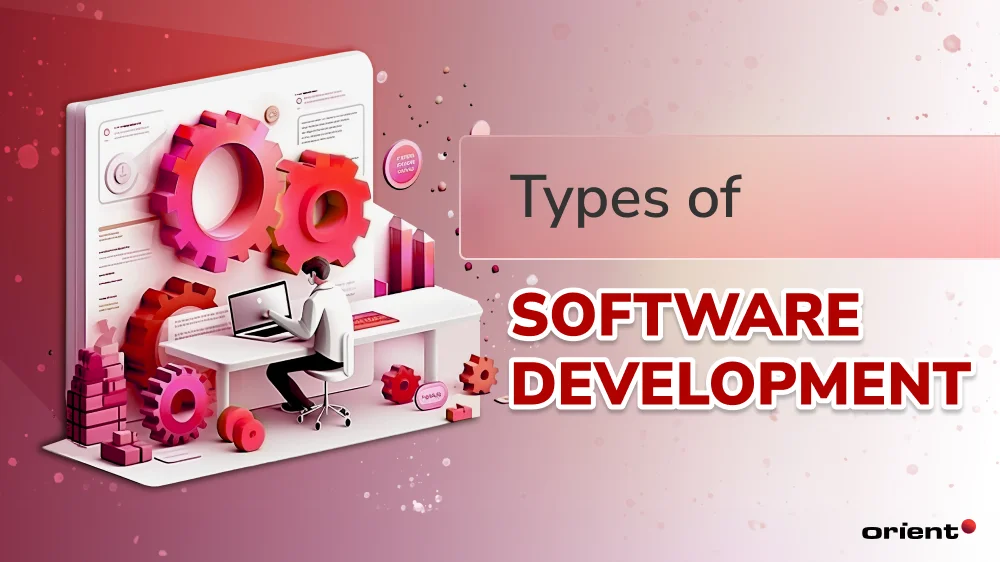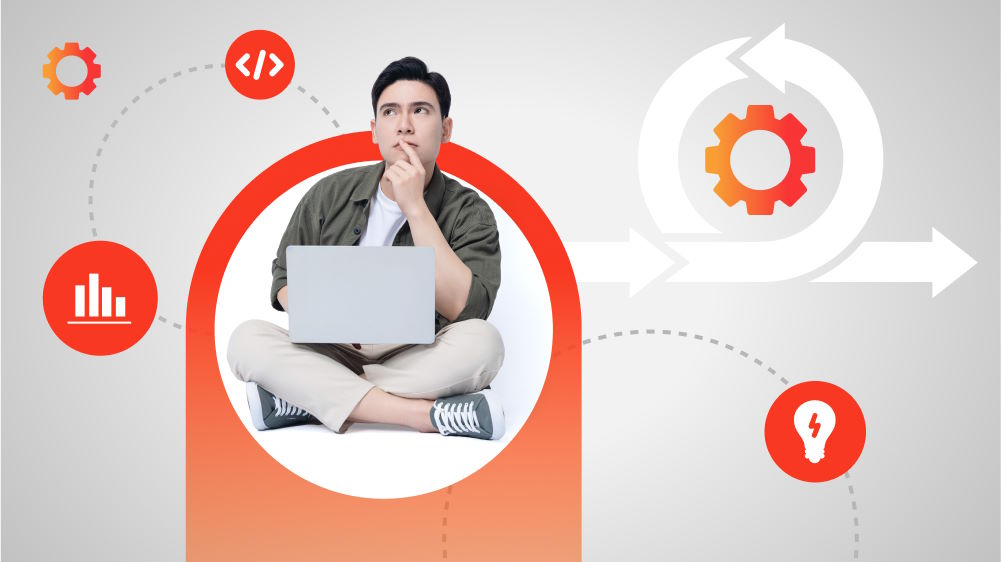A Tour Around the Most Common Types of Software Development

Content Map
More chaptersSoftware engineering is a vast, ever-evolving field that encompasses an extensive range of technologies, practices, and processes. One particular area within it is software development which covers a multitude of branches, each with its set of methodologies and tools, as well as respective use cases. Simply put, there are numerous different types of software development, and some are more common than others.
Are you brainstorming for your upcoming big idea of software engineering? Or have you landed a new job in the tech industry and are curious about the different types of software development? Well, either way, you have come to the right place. It will be useful for you to have a basic understanding of the various types of software development before diving into any projects or job roles. In more detail, we will give you a glimpse into each. So, read on.
Web Development & Web Application Development

Start with the simplest one, and arguably the most in-demand nowadays, when the demand for online presence of businesses or individuals is on the rise. It refers to creating websites, web-based applications (web apps), and services that are accessible through a browser, such as Google Chrome or Safari. Web app development is a subset that particularly focuses on developing web-based applications – dynamic websites that can perform like mobile and desktop apps.
Both web development and web app development are usually client-centric, meaning the client is responsible for providing a business case and requirements for the software solution and a general idea of what they strive to gain from it. The development process typically involves several tasks, starting with ideating and designing user interfaces, followed by building complex server-side logic and databases to store and retrieve data.
Some of the benefits of web development and web app development include its wide accessibility, affordability, and potential for scalability. Web-based solutions aim at a broader reach as they are accessible from various operating systems and devices with an internet connection. This approach is more cost-effective than native app development and less time-consuming compared to traditional desktop application development. Moreover, web apps have the potential to accommodate an increasing number of users without significant changes needed to the infrastructure.
In some circumstances, it is acceptable to group web development and web application development together as one type of software engineering. It is due to the fact that both approaches share multiple similarities and often overlap in skills, development needs (Many projects require a website and a web app component), tools, practices, etc. Nonetheless, web development covers a more significant array of tasks, such as UI/UX design, web content management systems (CMS), web hosting, and domain maintenance. Meanwhile, web app development concentrates more on building dynamic web applications with server-side functionalities.
Mobile App Development

In the smartphone era, where almost everyone owns a smartphone or even more, creating mobile software solutions has become a huge industry. With an estimated two billion smartphone users worldwide, there is no telling how many applications are created and launched every day to keep pace with the user demands across fields, especially in entertainment, social media, and business. What a massive number!
Mobile application development refers to the concept of designing and crafting mobile-based software that solely runs on smartphones and tablets or supplements web-based counterparts. iOS and Android are the two predominant operating systems for mobile app development, and each calls for its own specifics and unique functionalities. Therefore, mobile developers need to work with different tools, languages, APIs, and SDKs (Software Development Kits) to create applications tailored to a specific mobile OS.
Oftentimes, the development lifecycle of a mobile-based solution can be more intricate than that of a website or web app due to various hardware configurations, operating systems, screen sizes across different devices (App responsiveness), and multiple versions or updates of the OS. Still, mobile app development is a go-to path for many business owners or software developers thanks to its set of indisputable benefits. One of them is its potential for monetization. Mobile applications provide creators with multiple opportunities to make a profit through in-app purchases, advertisements, subscriptions, and more.
But do keep in mind that mobile application development is no easy route, as you are about to face high competition in the app market. The ever-changing nature of mobile technologies can also become your obstacle, as you need to keep up with and adapt to new trends and updates regularly.
Security Software Development

This is another popular branch of software development. In general, security software development is about creating software programs and tools designed to protect an organization’s data from theft, unauthorized access, or other malicious activities. This type of software development is often highly configurable, meaning it can work with different types of computer systems and surrounding infrastructure without issue. You can easily relate to multiple examples of security software around you, such as antivirus programs, firewalls, intrusion detection systems, etc.
While there are several benefits to security software development, a couple of key ones include its dependability and ability to safeguard sensitive data. Security software is also known for being one of the most secure forms of SaaS (Software as a Service) available, as it’s designed to protect sensitive data that could cause harm to an organization if lost or stolen.
Certainly, security software development does come with several drawbacks that should be considered before making a final decision. The most notable of these is its cost; this type of software development can often be one of the most expensive types of SaaS available. Additionally, some users may find it challenging to set up and install security software on their own effectively.
Desktop Application Development

Desktop applications can be seen as the earliest form of software that is still in demand today. Some prime examples include operating systems like Windows or MacOS, business software (Microsoft Excel), graphic design suites (Adobe Photoshop) or video games.
As the name suggests, this type of app development is building a software program for specific desktop operating systems (E.g., Windows, MacOS, or Linux).
In contrast with those running on web browsers or mobile devices, desktop applications are limited in accessibility and reach. Due to their nature, they require installation and compatibility with specific OS. But it does not mean that desktop application development is less important or in decline. In reality, a lot of businesses and organizations still rely on desktop applications to power their operations, as they facilitate more sophisticated features and functions compared to web or mobile apps.
API Development

API stands for Application Programming Interface. It serves as a gateway that connects computer systems to one another. APIs enable users to connect their social media profiles, data analysis tools, and other services, enabling these systems to work seamlessly together. They are becoming more popular due to their efficiency; instead of having several different applications performing separate tasks, application programming interfaces help automate workflows so everything can be completed swiftly.
Developing APIs requires a high level of technical expertise. Many companies hire dedicated teams specifically to work on their APIs. While APIs offer significant benefits, they also have some drawbacks. Most APIs are not very user-friendly, which can pose challenges for any users who are not familiar with the development process.
Cloud Software Development

It is a relatively new form of software development that has gained significant traction in recent years thanks to advancements in cloud computing technology. Cloud-based software applications refer to applications that are hosted on remote servers and operated online. It means users can access them using the internet instead of installing them on their local devices.
Business owners and companies no longer need to sink money into hardware infrastructure or maintenance costs, which are now falling onto the cloud service provider. Some examples of cloud software include Google, Dropbox, and Microsoft Office 365 suite.
Software Tool Development

This type is about designing and creating a software development tool that aims to aid developers in their work. In other words, these tools are created to simplify programming tasks. Some common examples include IDEs (Integrated Development Environments), code editors, debugging tools, or testing software. These tools cover a broad range of functionalities to support the entire development lifecycle.
While there are off-the-shelf tools available on the market, many companies choose to develop their own custom versions to align with their specific needs and workflows. On the plus side, this software type is affordable and easy to use; most users only need basic technical skills in order to get started.
Embedded System Development

Simply put, embedded systems are a blend of hardware and software designed to conduct a specific function or a set of functionalities within a larger system. Unlike general-purpose computer programs, embedded systems are often constrained by real-time performance requirements, power consumption, and size. Hence, they are highly specialized for the tasks they are intended to carry out.
This type of development can be used for various purposes, including automotive technology, robotics, and personal home products. You can find embedded systems in devices ranging from household appliances to complex industrial machinery.
Embedded systems development requires an extensive knowledge base of both hardware and software components. With the rising of Internet of Things (IoT) technology, embedded systems have become even more critical as they facilitate communication between devices and sensors. This also promises more possibilities for innovation in the near future.
Operating System Development

Abbreviated as OS, an operating system acts as a translator between the hardware and software to enable them to communicate and function well together. It handles interactions with various components, such as memory management, scheduling tasks for system resources, and controlling input/output operations. Most operating systems will either be installed by users or pre-installed by the manufacturer before being sold, like an embedded system.
The “tech titans” like Microsoft, Apple, and Google have their own proprietary operating systems for different devices, such as Windows, MacOS, iOS, or Android. The OS development process is a complex one, and it often requires advanced knowledge of programming languages, system architecture, and computer science, particularly in areas such as algorithms, data structures, and hardware-software interaction.
Front-end Development

It is often referred to as UI (User Interface) development. This type is accountable for creating and maintaining the user-facing components of software applications. For example, the colorful and interactive buttons on a social media website are the result of front-end development.
The development process involves writing code in HTML, CSS, and JavaScript, along with using many different libraries and frameworks, such as React, AngularJS, or Vue.js. This type of software development requires knowledge of web design principles, responsive design techniques, cross-browser compatibility, and user experience best practices. A well-designed front end can bring great differences in user engagement and satisfaction.
Back-end Development

The back end is what happens behind the scenes, be it the server side of things.
Server-side or backend development primarily involves working with databases, servers, APIs, security, and the core functional logic of a website or a software application. Developing the back end of any application or tool requires solid programming skills and knowledge of server-side languages such as Java, Python, or PHP or frameworks like Django, Spring, or Laravel. In addition, backend developers must be proficient in database management and server-side scripting.
This type of development is crucial in forming the foundational structure of any software and making sure it runs smoothly. Without a well-designed back end, even the most user-friendly front end could struggle to function correctly. In server-side development, front- and back-end developers should work hand in hand to ensure the user interface integrates seamlessly with the backend processes.
Full-Stack Development

The name speaks for itself. The definition of full-stack development is about building both the front and back ends of a software system, considering all aspects, including data layers, business logic, integration with APIs, user interface design, and more.
This is a highly versatile type of development as it enables developers to control the entire product, from server-side processes to user-facing components. Known as the jack of all trades, full-stack developers must have a strong command of both front-end and back-end development expertise. They are able to work on every layer of the software’s architecture, from design, database management, and server-side coding to user-facing interfaces.
Database Development
A database is meant to be a central location for storing data in an organized manner. This type refers to the creation, implementation, and maintenance of such a structured collection of data. This type can be separated into three main categories: Relational databases, object-oriented databases, and unstructured databases.
The most popular type of database used today is the relational database, which relies on a structured query language (SQL) to manage data stored in tables. Object-oriented databases are more suited for storing complex data types, which can be beneficial in developing applications that utilize artificial intelligence or machine learning. Unstructured databases, also known as NoSQL databases, enable developers to store large volumes of data without strict organization requirements.
Database developers are responsible for the structure and functionality of a database. So, they must have deep expertise in designing efficient database structures, writing optimized queries, and implementing security measures to protect sensitive data.
Partner with Us for an Efficient Software Development Lifecycle

Who are we? We are Orient Software - a top-tier service company based in Vietnam with nearly two decades of experience in the outsourcing industry.
Why choose us? At Orient, we have experts who handle projects of all software development types. We provide our esteemed clients with a complete suite of outsourcing services, notably custom software development for various project types and scales. We are not merely a service provider; we grow as you grow. Our mission is to be your one-stop outsourcing service provider for all your IT needs, and we take pride in being skillful at it. Furthermore, we are confident in our efficient processes and our adaptability to cutting-edge technologies so that we can deliver only high-quality results to our clients.
You can entrust us with your software project or have us build a dedicated team of specialists work exclusively for you. If you want to expand your current team, we can also empower you with augmented tech talent. Whatever you require, we can commit to each and every software developer you add to your team being one of the best caliber candidates.
Why hesitate when you can meet up with our experts and actually discuss your requirements in further detail? Don’t wait any longer and hit us up now!







